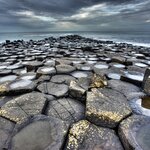Geology

ome 250 million years ago, in the time when life was recovering from
The greatest mass extinction of all time, the Permian-Triassic mass extinction 250 million years ago, killed 95 percent of life, and the very few survivors faced a turbulent world, repeatedly hit by ice ages, rapid warming and ocean acidification cycles.
Through all of that, two main groups of tetrapods survived; the synapsids and archosaurs, ancestors of mammals and birds. And a new study find that the ancestors of both mammals and birds became warm-blooded at the same time.
Endothermy, warm-bloodedness, is the…

The East Kootenay region on the south-eastern edge of British Columbia is a land of colossal mountains against a clear blue sky.
That is not strictly true, of course, as this area does see its fair share of rain and temperature extremes — but visiting in the summer every view is a postcard of mountainous terrain.
Rocks from deep within the Earth's crust underlie the entire East Kootenay region and are commonly exposed in the areas majestic mountain peaks, craggy rocky cliffs, glaciated river canyons, and in rock cuts along the highways.
Ice Age sediments, deposited during the Ice Ages,…

Don't be fooled by those tourist volcanoes that reliably produce small basaltic lava eruptions. A new study shows they hide the same chemically diverse magmas in their underground plumbing systems as volcanoes that generate explosive activity.
Some volcanoes in Iceland, Hawai'i and the Galápagos Islands consistently produce lava flows of molten basaltic rock which form long rivers of fire down their flanks. They are so slow, you can outwalk them, and therefore so predictable you can visit them but unless you build a house in front of one, they are safe.
Yet they share chemistry in…

Bad things come in threes, it is said, and nothing shows that more than The Carnian Age; the first stage of three in the mass extinction era of the Late Triassic Epoch 228 to 217 million years ago.
It had three features; dramatic climate change with much higher humidity, the first dinosaurs appeared, and gigantic volcanic eruptions called the Wrangellia large igneous province spewed out greenhouse gases.
For dinosaurs, climate change was a good thing because plant life grew, thanks to the humid conditions and higher carbon dioxide. That event, now called the Carnian Pluvial Episode, may have…

How did the continents form? It's a complex question, and no firm answers will be coming soon, but the oceanic plateau of the Kerguelen Islands may provide part of the answer, according to a new paper.
From a geological point of view, it is the Earth's outermost layer that distinguishes the continents from the oceans: oceanic crust, which is relatively thin, is mainly made up of basalts, resulting from the melting of the Earth's underlying mantle, whereas continental crust, which is thicker and of granitic composition, is derived from magmas that evolved at depth before solidifying.
Such…

From Australian wildfires to COVID-19 to murder hornets to race wars in Manhattan, 2020 looks to be a challenging year. It could still get worse, but science shows it won't be due to Yellowstone blowing its top.
Yellowstone is one of those scenarios doomsday "preppers" worry about. They are right to be concerned if it does happen, but they don't understand hazard (what could happen) and risk (the likelihood of the hazard) any better than environmentalists worrying about weedkillers do.
Eruptions can have short-term consequences; 1980's Mount St. Helens eruption in Washington, for…

Because Australia was discovered late by Europeans it is considered an old continent with little geological activity, but a new study reveals that its mountains are still growing. Some parts of the Eastern Highlands of Victoria, including popular skiing destinations such as Mt Baw Baw and Mt Buller, may be as young as 5 million years, not the 90 million years thought by many.
The findings result from speleothems - stalagmites, stalactites, and flowstones - in the Buchan Caves.
Using classic uranium–lead dating, scientists found that the East Victorian Highlands had grown nearly 800…

About 74,000 years ago on the island of Sumatra, Indonesia, the largest volcanic event over the last two million years, 5,000 times larger than the Mount St. Helen's eruption in the 1980s, ushered in a worldwide "volcanic winter" that lasted up to ten years followed by a 1,000 year-long cooling of the Earth's surface.
While how close humanity got to extinction is unknown, surviving Homo sapiens in Africa were said to have survived by developing new strategies that eventually enabled them to re-expand and populate Asia 60,000 years ago in a single, rapid wave along the Indian Ocean…

Dr. Norm Borlaug, the "father of the Green Revolution", is credited with saving a billion lives using agricultural science, and for the last 50 years he and his successors debunked the Malthusian claims of cynics like Paul Ehrlich, John Holdren, and their modern-day acolytes like Bill McKibben, Michael Pollan, and Naomi Oreskes.
When Holdren and Ehrlich (and the other Ehrlich) were trying to drum up support for mandatory birth control and a world government to enforce it(1), Borlaug and the science community quietly made farming more efficient than ever. Today, even the poorest people in most…

The Giant's Causeway is a spectacular expanse of interlocking hexagonal basalt columns formed from volcanic eruptions during the Paleocene some 50-60 million years ago.
These columns tell a story of the cooling and freezing of the lava flows that formed them. As lava at the surface cools and freezes, it also shrinks as its molecules rearrange themselves into a solid structure. This happens much more quickly at the surface where the lava comes in contact with moist, cool air. As the basalt cools and shrinks, pressure increases in intensity and cracks begin to form. A way to dissipate this huge…